Yesterday I said I was eyeing a record for photos this year, but was running a little behind on what should be a fairly intensive end stretch. That had nothing to do with this. Nothing!
Okay, maybe a little…
I also mentioned needing to go around and chase fall colors, and so I did, kinda. I never left the yard today (well, yesterday now,) but found a decent selection nonetheless.

We made a small mistake when placing the two oak-leaf hydrangeas (Hydrangea quercifolia) in the yard, in that neither one gets direct sunlight later in the year when they do their magnificent color change. This is probably for the better, because they’d be broiling during the summer and they’re not the best plant for direct sunlight, but it does mean that I’m always working in shadow with them. They produce the best autumn foliage of any plant that I’ve seen – well, maybe, and we’ll come to that. But I recommend them for anyone’s yard that can handle them. Here, the slower shutter speed worked against me a little, since this isn’t at optimal sharpness, though I may return and do some shots with either a higher ISO or a tripod.
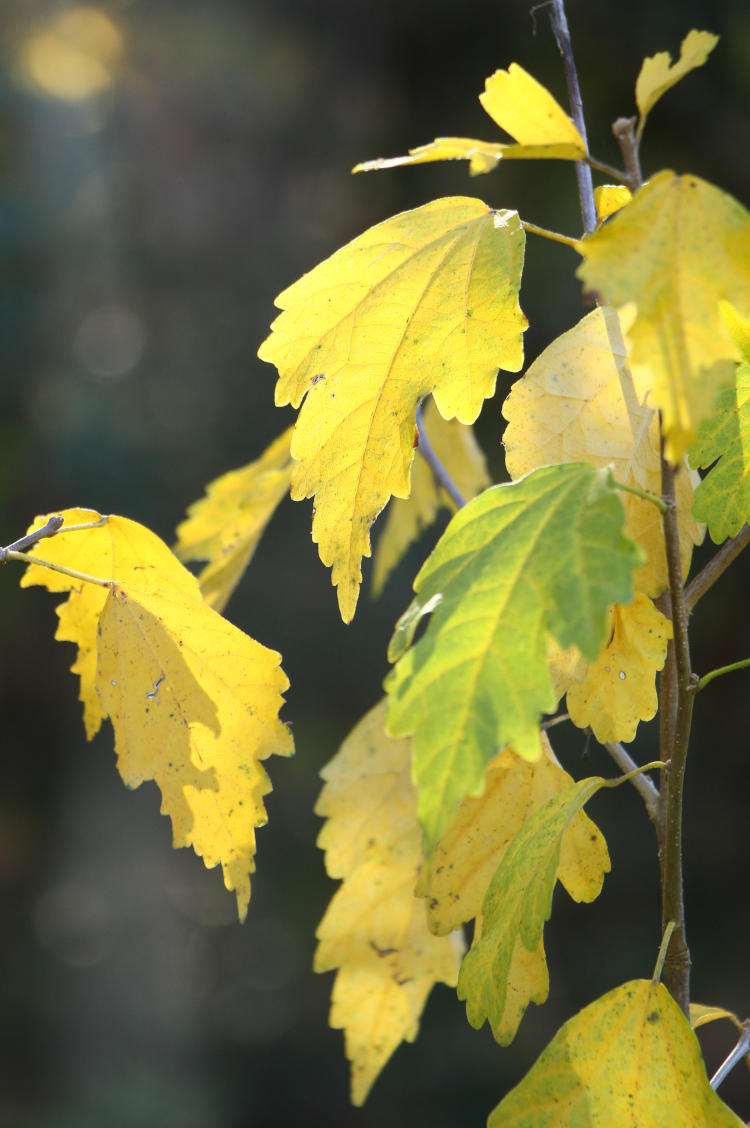
Nearby, the newly-uncovered Rose of Sharon (Hibiscus syriacus) has been doing a late summer recovery after being overwhelmed by vines and competitors in The Jungle, which I finally cleared out this past August. It sported a few buds when I uncovered it, but unfortunately the deer were delighted with that and did some damage before I realized how much they liked it. I began treating it with repellent, a homemade concoction that tastes horrible, apparently, and thus works wonders – it kept the decorative sweet potato vines intact all this season, and they were like candy to the deer.
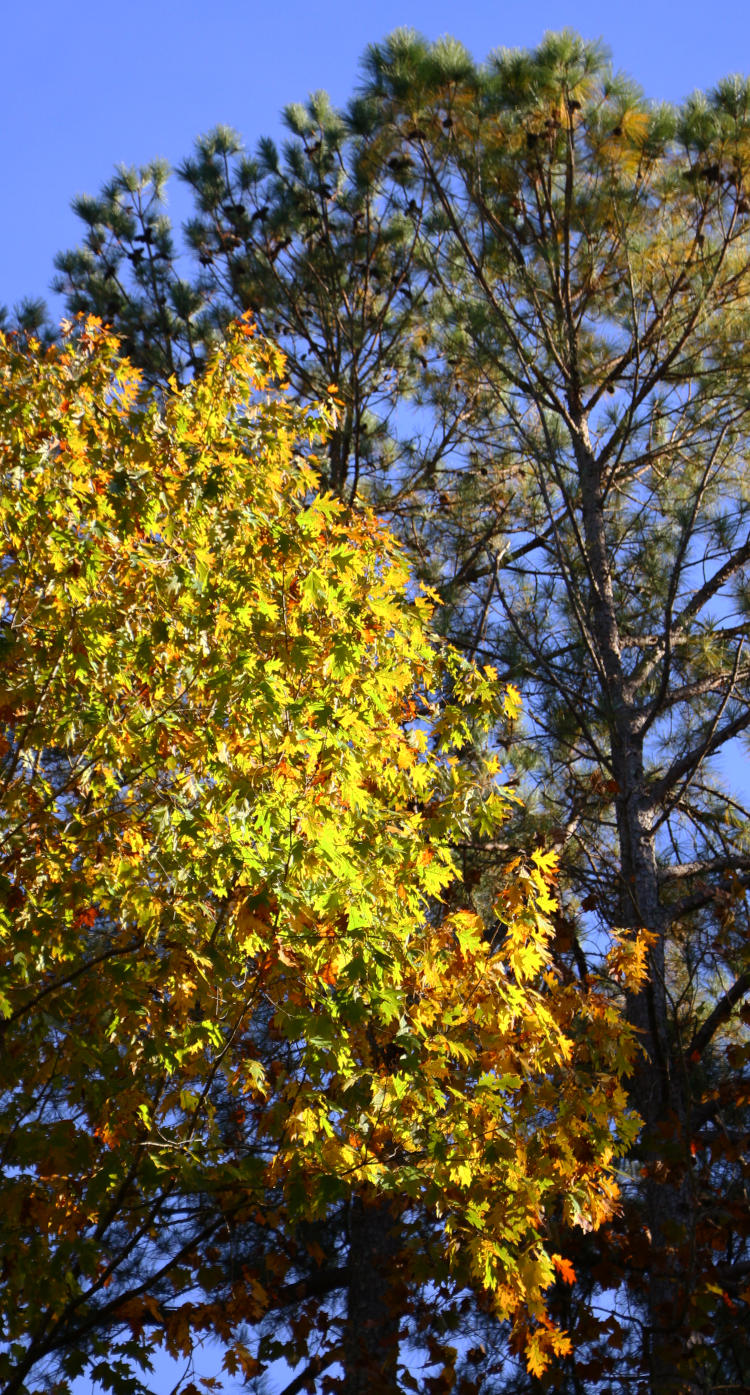
We’re close to peak fall colors here, but as I’ve said before, it’s a little misleading. The various trees native to the area all turn and shed at different times and rates, so a handful of them are already going bare, while others, like this oak sitting on the property line, won’t peak for a little while yet. I purposefully contrasted this with the longneedle pine just to show how ugly those are – the oak will go bare in a few weeks and still look better than this unhealthy-seeming crap pine. Have I mentioned how much I detest those?
This has actually been a great year for the colors. In my experience, being too dry makes the leaves tend towards brown, but the summer drought ended early enough to produce some great colors in the deciduous trees. Of course, I could be wrong about the cause, but no matter – whatever it was, worked.

The resident Japanese maple out front, the one that was here when we moved in and has served as a setting or backdrop to countless photos, responded well to the season and produced the best colors that I think I’ve seen from it. Here I found a spot along the edge where I could capture the still-changing hues in layers, and get a little fartsy. That’s gonna get worse.

One of the various newer Japanese maples, most of which remain in pots, displayed some great colors last year, and so I was watching it this year to see how it developed. Four days ago, it was showing only the barest hint of color change along the tips of some of the branches, and I was a little concerned that it wouldn’t show off well this year.
I needn’t have worried.
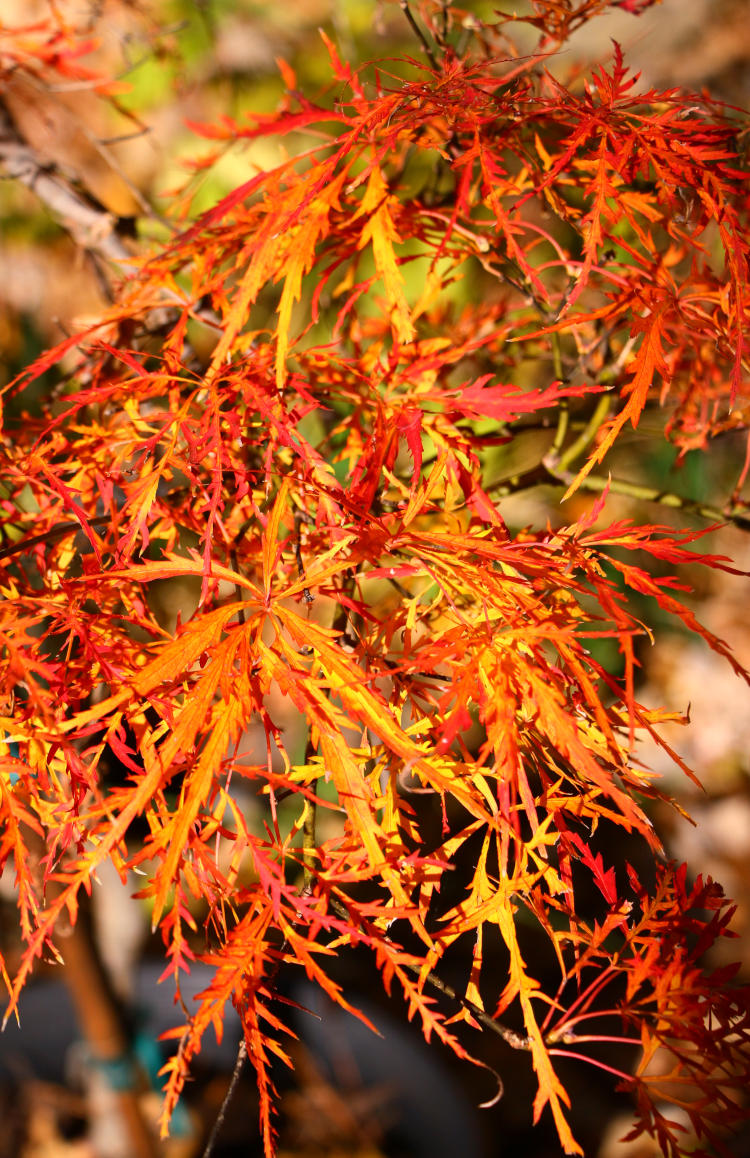
The color change was very rapid and quite gratifying, and I was glad I was paying attention, because I watched a few of the leaves drop in the breeze as I was doing these photos. But it was looking so good that I had to make it the subject of extended efforts.
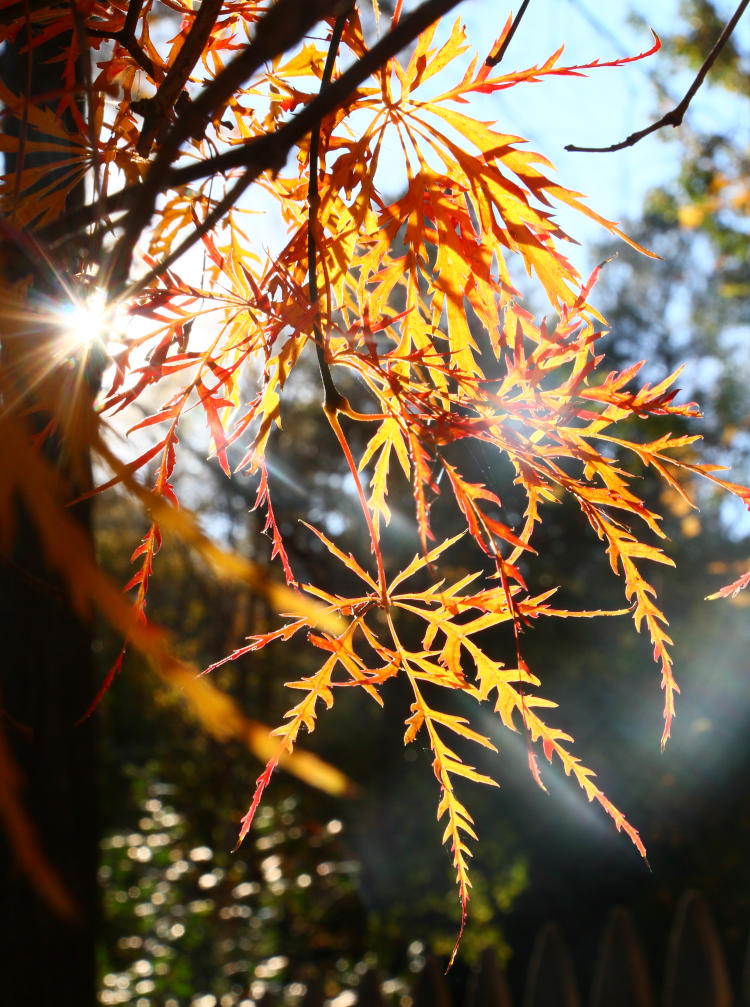
I had shot some initial images of this color change with an Olympus 50mm f1.4, a lens from my very old Olympus kit, fitted with an adapter for the Canon body – I was experimenting to see if it might serve better during night exposures, like for the Leonids. Unfortunately, it performed rather dismally, especially wide open, so while I might try it for the high-ISO, long exposure starscapes that will be dominated by grain anyway, the test shots of the Japanese maple really aren’t worth keeping, so I reshot a bunch with the Canon 18-135mm. By that time, the sun (sitting much lower in the sky now) had moved on and thrown the tree into shadow, but it’s still potted, so I lugged it over to a sunny spot to do these photos. For this frame I closed the aperture down to f16 and leaned back and forth until I just had the sun peeking from behind a trunk. The flare in the lower quadrant was unavoidable, but I’m okay with it given the nature of the shot. You did notice the congruence between the shape of the leaves and the sunburst, as well as that one prominent leaf lobe falling right in line with the sun itself, right? Okay then.

It appears almost all of the various Japanese maples (I’ve lost track of how many we have – six, I think,) produced just a handful of seeds this year, called samaras. We should probably make the attempt to germinate a few, especially from this tree, though I’m not holding my breath because I suspect that they’re all hybrids. But it served its purpose as a subject for this tighter abstract when the light hit it.
This, by the way, is the one vying for the title of “Best Autumn Coloration” with the oak-leaf hydrangea up there. This one is more brilliant, but the hydrangea will retain its leaves for quite some time while this one will be bare within a week or so. All depends on what you want most, I guess.
Moving on now.
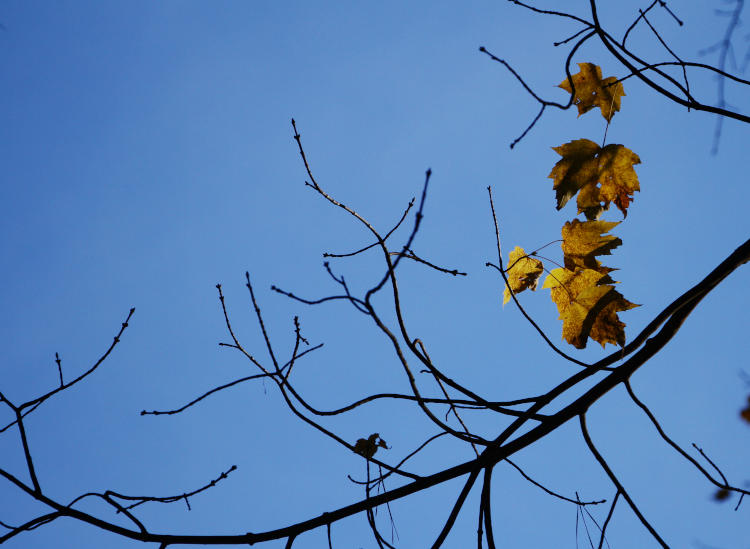
Remember what I said about different peak times? This tree (some kind of maple I believe – I don’t know, it’s the neighbor’s,) peaked early and is now almost bare, the shed leaves pretty much covering the backyard of Walkabout Estates – it’s next to impossible to tell that there’s actually water in the pond. But, still being fartsy, I found this cluster of survivors just barely catching the late afternoon sun. You can call these the midmonth abstracts if you like.

I kinda consider this one my representative autumn shot. Not as bright as some of the others, it’s actually the most common color seen in the area, and the sun flare gives the impression of the frequent patches of blinding sunlight that occur because of the lower sun and the no-longer-screening trees. It’ll do for now, at least.
I’ll close with another strong one, actually the impetus to go out and do some shots (besides the lens tests, I mean.)
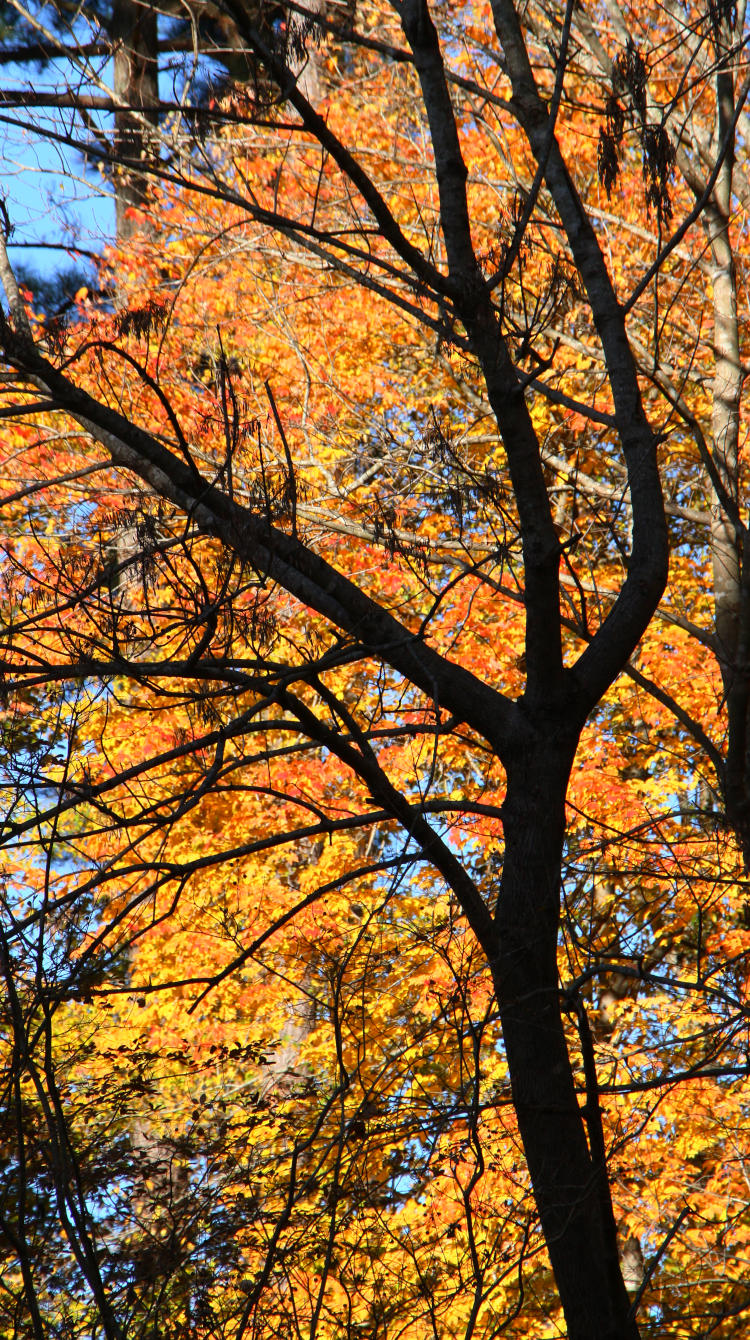
This is actually a portion of the view out the front windows, only visible like this for an hour or two right at this time of year – the sun gets lower and breaks past various other trees to illuminate the colors of the background tree, while being shadowed from the intervening trunk. There are a lot more branches in there than I’d really like, but it was nigh-effortless, so who’s complaining? And the contrast still works well. Might have to try it in monochrome.
Stay tuned – I may still get out for a drive looking for more examples.



















































